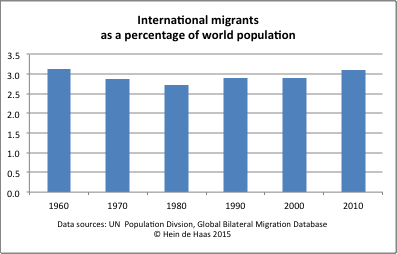
The Myth of Invasion
Published onBy Hein de Haas
Many people believe that migration is at an all-time high and accelerating fast. Images of people crossing the Mediterranean in ramshackle boats and rising political panic about immigration all contribute to the image that migration is rising rapidly and that drastic measures are needed to stem the tide.
These voices are not only coming from anti-immigrant parties and extremist groups. In fact, the idea that migration is rising fast has become mainstream over the past years. Every year again, organisations such as the International Organisation of Migration and the United Nations Population Division hit the news headlines with reports that migration is at an all-time high and will accelerate in the future.

International migrants as a percentage of world population
Some academics sing from the same hymn sheet. For instance, Oxford-based economist Paul Collier has recently published a book under the title Exodus. Underpinning Collier’s rather gloomy – albeit surprisingly uninformed – view is that future migration risks to reach such high levels that it will start to become harmful for both poor (origin) and rich (destination) societies.
This all adds to a crisis narrative around migration, with politicians portraying soaring migration as a potential threat not only to the welfare state, but also to the cultural integrity and security of European, North American and other destination societies.
The frequent sinking of boats transporting migrants and refugees to southern Europe (and Australia) and continuing irregular migration from Mexico to the United States contributes to idea that rich countries are ‘under siege’ of a rising tide of immigration driven by poverty, warfare and environmental crises in poor countries; and that drastic measures are needed to stop this ‘exodus’. This further add to the overriding feeling of an impending migration invasion.
However, the best available data defy the whole idea the world migration is accelerating fast. Certainly, in absolute terms, the number of international migrants has increased fast, from an estimated number of 93 million in 1960 to 214 million in 2010. Yet the world population has increased at a similar pace. The number of international migrants as a share of the world population has therefore remained remarkably constant at levels of around 3 percent (see the graph above).
So, global migration rates have remained remarkably stable levels. But why do we still think that migration is increasing fast?First of all, migration has become a political hot topic and is receiving massive media attention. Interestingly, both conservative and progressive forces have a certain interest in playing into fears of mass immigration. Right-wing politicians routinely scapegoat migrants to win the next election through portraying migrants as a cultural or terrorist threat or potential welfare scroungers while also left-wing politicians and trade unions have often portrayed migrants as people who steal jobs from native workers or undercut their wages.Also international organisations dealing with migration have a certain interest in migration being seen as an urgent issue ‘in need of management’ to justify their own existence, increase their perceived relevance and boost their funding.Development and humanitarian organisations regularly play into deep-seated fears of uncontrolled mass migration to advance their own agendas. For instance, you can frequently hear the argument that more development (through aid or trade) is the only way to curb migration. Many politicians and NGOs have often argue that climate change and environmental degradation, if remained unchecked, will cause mass migration.While such arguments are based on the deeply flawed assumption that underdevelopment, poverty and violence are the main causes of migration (on the contrary, development rather leads to more migration), by using such arguments politicians and development NGOs (wittingly or unwittingly) play into and reinforce the idea were are facing an impending migration invasion if nothing is done. This is not to say that their concerns about issues such poverty, conflict and climate change are not valid; but rather that they are ‘right for the wrong reasons’.
‘Euro-centrism’ is the second reason for the misconception that global migration is accelerating fast. While global migration rates have remained remarkably stable, there have been major shifts in the dominant direction of migration.Since the ‘discovery’ and subsequent occupation of the America by Europeans five centuries ago, Europeans have invaded and conquered overseas territories while subjugating, killing or enslaving murdering their native populations – without asking permission. This was arguably the biggest illegal migration in human history.European emigration reached unprecedented levels in the 19th and early 20th centuries. Douglas Massey, a prominent migration researcher, has shown that, only between 1846 and 1924, some 48 million Europeans moved out, which is equal about 12 percent of the European population in 1900. For some countries, emigration was much higher. For instance, in the same period, about 17 million people left the British Isles, which is equal to 41 percent of Britain’s population in 1900.
Since the end of World War Two, the direction global migration patterns has been reversed. As a consequence of decolonisation, high levels of economic growth and a drop in birth rates, European emigration has plummeted and Europe has evolved into a global migration destination.
This reversal of European migration has affected the global face of migration. The post-War decline of Europe as a global source of migrants has led to an increasing presence of African, Asian and Latin American migrants in Europe, North America, Australia and New Zealand. The transformation of Europe from a continent of emigration to a continent of immigration has changed the face of European and European settler societies, often leading to heated debates around ‘integration’ and national identity.
So, from a Euro-centric perspective, migration may seem unprecedented in terms of the increasing diversity of immigrant populations. From a global perspective, this view simply does not hold.
*For more information and data see this study: The globalization of migration: Has the world become more migratory? by Mathias Czaika and Hein de Haas. International Migration Review 48(2): pp. 283-323, 2014.
 Source: Reprinted with permission from the author. Originally published May 1, 2015 on the Hein de Haas blog.
Source: Reprinted with permission from the author. Originally published May 1, 2015 on the Hein de Haas blog. 





